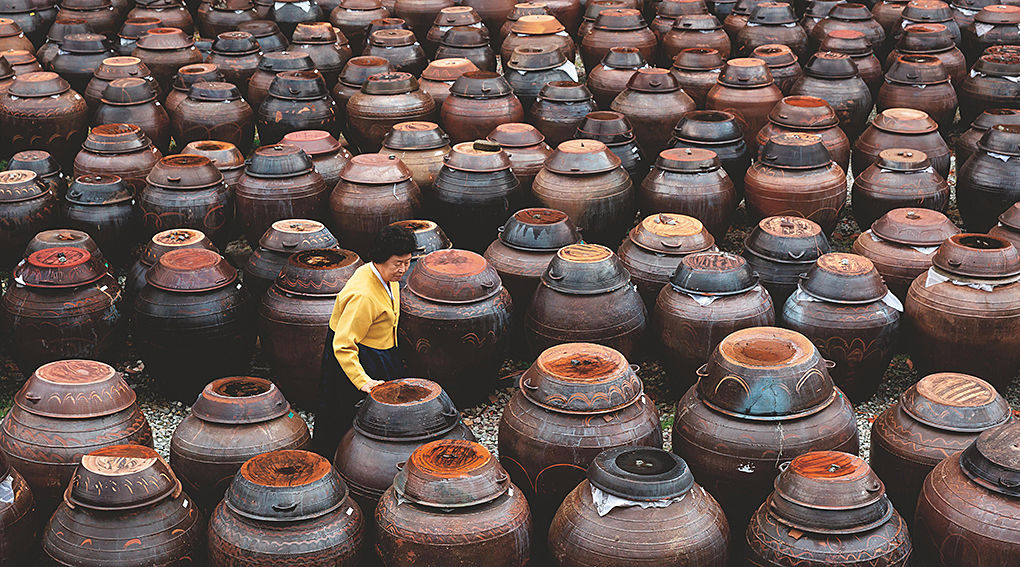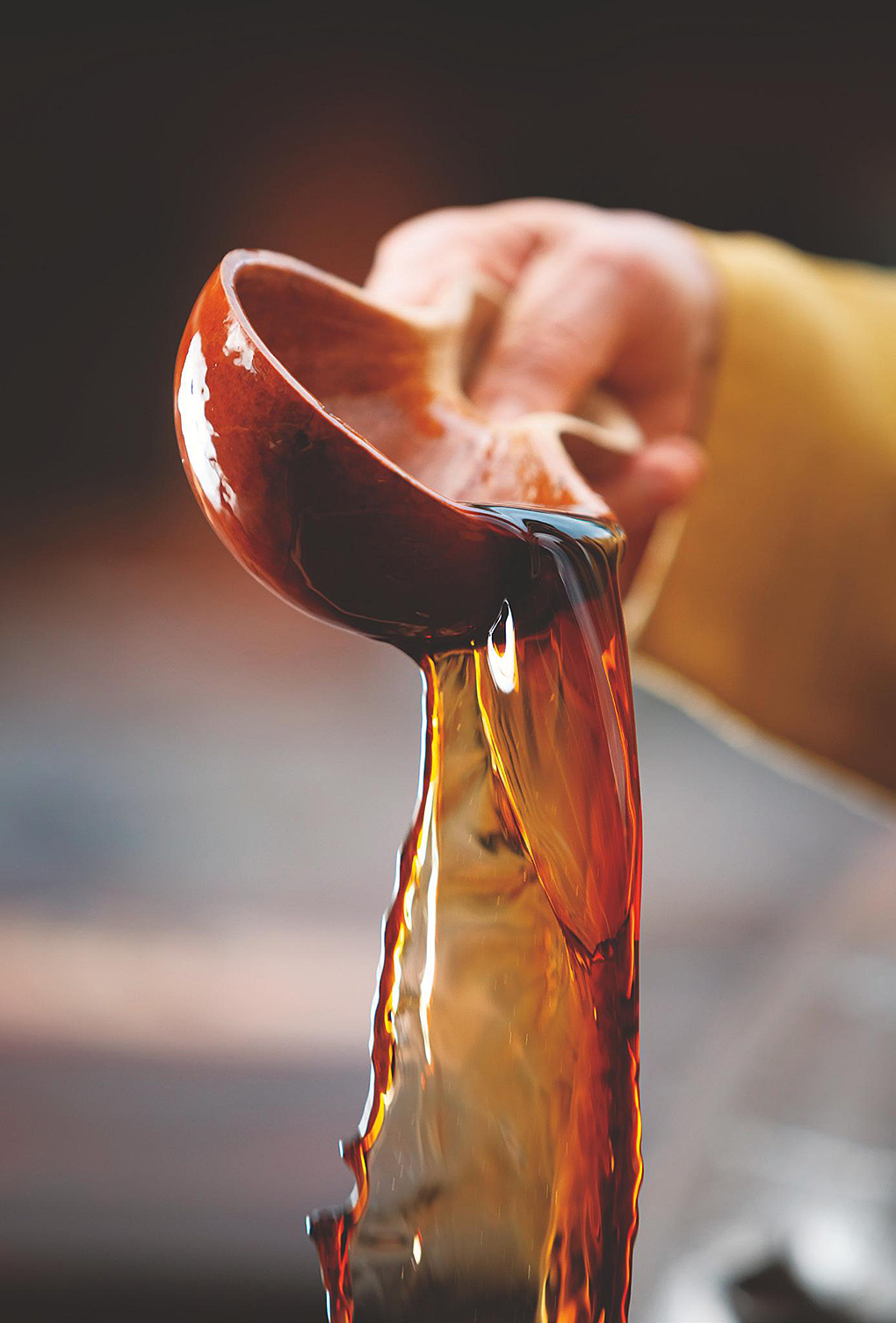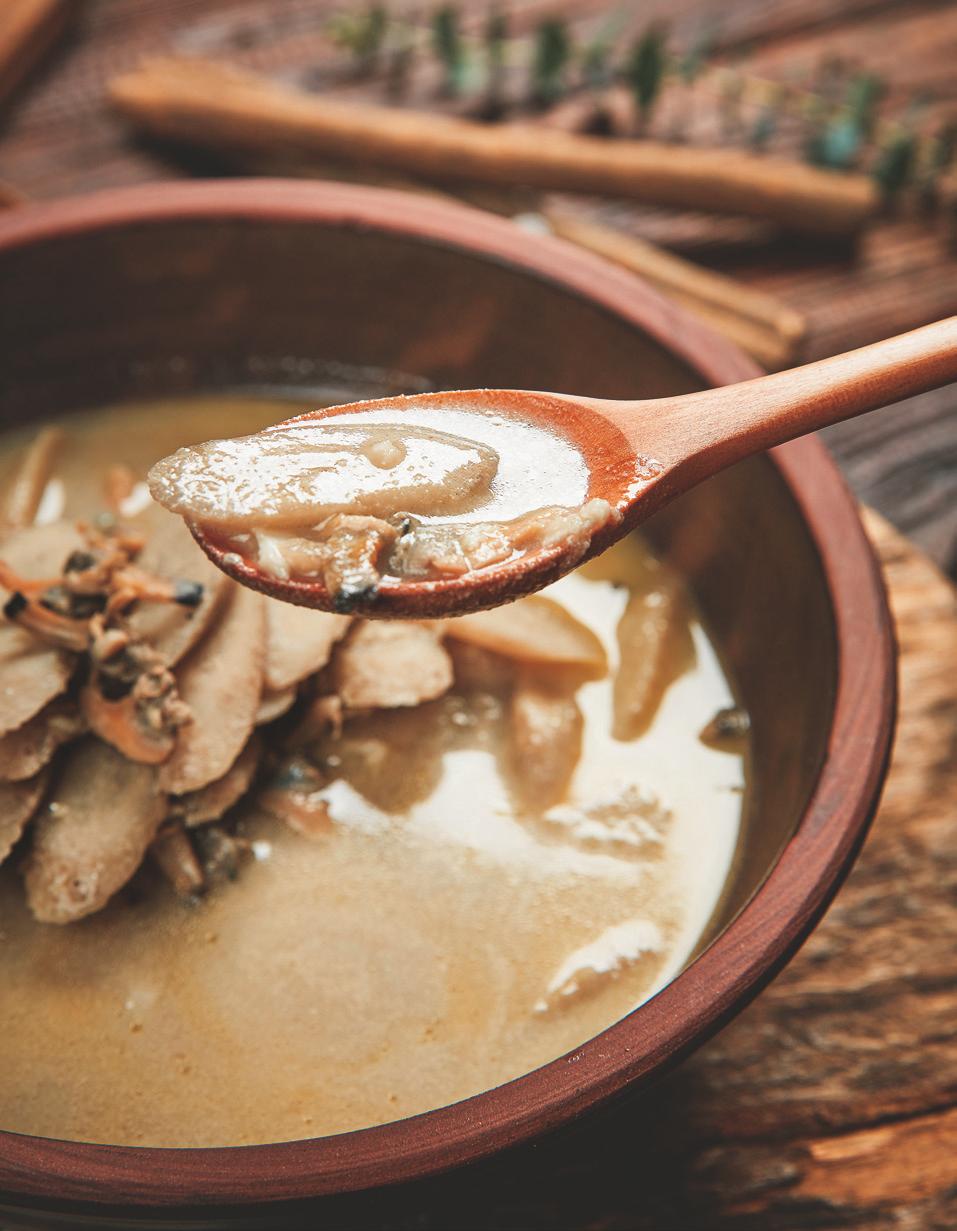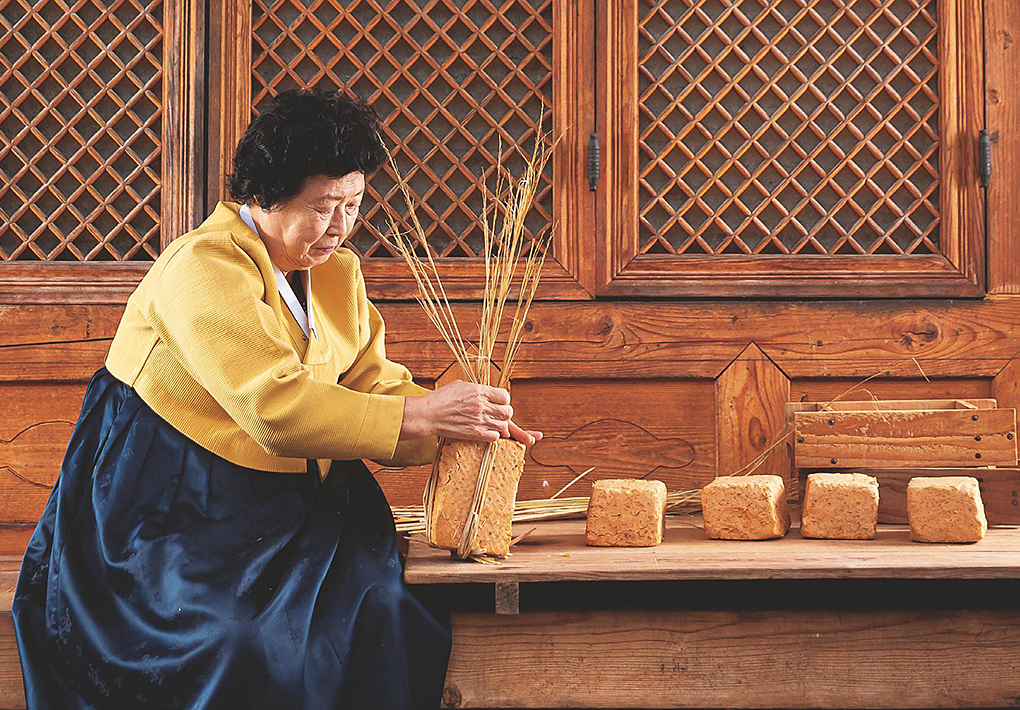Fermentation, which requires time and care, is an essential feature of traditional Korean cuisine. Of all the fermented Korean foods known for their deep, savory flavors, ganjang (soy sauce) is a basic ingredient treasured in every household. One family in particular has preserved its soy sauce for 360 years, with the duty of safeguarding the heirloom sauce passed down through the eldest daughters-in-law.
“I hope it wasn’t too much trouble coming all the way out to this remote place where there’s nothing much to see,” Ki Soon-do said with a gentle smile. She had the elegant, generous aura one might expect of the mistress of the head family of a clan, and her words had a pleasant hominess reminiscent of well-fermented soybean paste (doenjang). A white dog followed her around, receiving guests with her.
Ki has made jang (fermented condiments) for the last 48 years, and her commitment was recognized in 2008 when she was bestowed the title of Master of Traditional Korean Food No. 35. This certification from the Ministry of Agriculture, Food and Rural Affairs is an honorary title granted to traditional food producers who have either specialized in a specific food item for over 20 years or trained under a master for over five years and specialized in one particular item for over 10 years. Ki was named master in the production and processing of jinjang, which refers to soy sauce aged for over five years.
Located in Asia’s first “slow city” authorized by Cittaslow International (a designation awarded to cities that prioritize quality of life, cultural preservation and environmental protection), her home in Damyang, South Jeolla Province has a spacious courtyard with a terrace holding some 1,200 earthenware jars standing in rows like well-trained soldiers. These jars contain a variety of condiments in diverse stages of fermentation.
“Why don’t you try smelling them?” asked Ki, leading me by the elbow to one of the jars. I opened the lid and an extraordinary aroma came from its contents: the unique musty smell of a fermented food, but with a peculiar sweet scent.
Ki largely makes three kinds of soy sauce. Cheongjang, thin sauce fermented for less than a year, is used for seasoning clear soups like kongnamul guk (bean sprout soup) and oi naengguk (chilled cucumber soup). Jung ganjang is darker and saltier, fermented for less than five years, and is best for dishes such as bulgogi (sliced, marinated and barbequed beef) and jangjorim (meat boiled down in soy sauce). Lastly, jinjang, aged for over five years, is the thickest kind and is used to make yukpo (beef jerky) and yakgwa (sweet fried cookies), among other foods.
To make each of these soy sauces, freshly harvested yellow soybeans are boiled, crushed and shaped into blocks called meju, which are dried on rice straw to ferment. The blocks are then immersed in brine for a few months before they are finally separated into soy sauce and soybean paste.
“On the day that I boil the soybeans, I take a bath beforehand to cleanse myself of all impurities. I never go to a house that’s in mourning around that time, however close I might be to the deceased. I devote myself to the work, body and mind. I’ve always regarded the first step in making soy sauce as a sacred task,” Ki said.

The rows of over 1,200 earthenware jars in the courtyard of Ki Soon-do’shome in Damyang, South Jeolla Province, make a spectacular sight. Ki hasmade condiments using traditional methods for the past 48 years. In 2008,her contribution to sauce making and the quality of her products earnedher the title of Master of Traditional Korean Food No. 35.
Utmost Devotion
Thanks to her decades of dedication and care, Ki’s name is also known abroad. Some of the world’s most renowned chefs, like Eric Ripert from New York and René Redzepi from Copenhagen, have visited her. And when U.S. President Donald Trump made a visit to Korea in 2017, her soy sauce made headlines for its use in marinating the beef ribs served at the state banquet. Press reports said the dinner featured a vintage soy sauce which was a century older than the United States itself.
“I’ve always taken good care of this seed sauce, which is rarely used except for special family events. Every year, I add the best soy sauce from the new batch to make up for the consumed portion,” Ki said.
Ki carefully chooses each ingredient in her soy sauce, using only bamboo salt and domestically grown soybeans. But her sauce’s secret, she says, lies in the water, the most basic ingredient, which is pumped up from the ground as deep down as 167 meters, and in the locally grown bamboo canes used for baking the salt in her brine. Her home county of Damyang is famous for its bamboo. Great ingredients naturally make for great taste, but it is skill that ensures soy sauce of the finest quality. Ki’s bamboo salt is different from any other on the market. “Bay salt from the west coast is baked for four days in a red clay kiln heated to about 700ºC, and this is repeated nine times to produce the salt that I use,” she explained with pride in her voice.
“In the eleventh lunar month, we cook soybeans to make meju. The meju blocks are fermented for a month, and ready for soy sauce making around the 15th day of the new lunar year,” Ki said. “Selecting the day for the job is very important. There is no practice run. The soy sauce, made just once a year, determines the taste of the family’s food for the whole year.” Her fermentation room, built with red clay, removes the musty smell unique to meju and s the sweet aroma of her soy sauce.
“You must be hungry by now. Would you like some of these? There’s almost no sugar in them,” she said, bringing in a small portable table laid with danggeun jeonggwa (carrots preserved in honey), doraji jeonggwa (bellflower root preserved in honey) and some yakgwa cookies.
Heirloom Recipes

Ganjang (soy sauce) is a basic seasoning used in Korean cuisine. Inthe past, making soy sauce was an important yearly event for everyhousehold, with the subtle difference in taste at each household highlyappreciated. But most Koreans use store-bought soy sauce these days.
Ki’s culinary skills are not confined to condiments; she is famous for various traditional dishes. Indeed, one bite of her sticky honeyed bellflower root was paradise in my mouth, the taste so elegant that the word “sweet” could not truly do it justice. The initial sweetness was followed by a pleasant bitterness. The cookies also had a delectable texture, not too crunchy or brittle. The grain syrup creating their lovely flavor needs to be made from scratch, Ki said, instead of using ready-made starch syrup, convenient as it may be.
As if she sensed that I was thirsty, she served me a bowl of sikhye (sweet rice drink), which also tasted different from the kind I had drunk before. It was less sweet and had more rice grains floating in it. The gentle sweetness came from the cooked and fermented rice, and the malt for the drink was also made from scratch by sprouting barley.
Ki is the 10th-generation jongbu of the Yangjinjae (House of Cultivating Truth) branch of the Ko clan, which hails from Jangheung, South Jeolla Province. Jongbu refers to the eldest daughter-in-law of the head family of a clan (jongga), who is invested with the duty of preserving the family’s traditions, including its dietary culture. Most clan head families developed their own dishes, with recipes passed down through the generations. These are high-quality local foods that make the most of regional produce.
The Ko family’s recipes include perilla seed soup with burdock root, pan-fried bamboo shoots, soy sauce kimchi, and rice wine brewed for 100 days. The perilla seed soup is made by stir-frying sliced burdock root, mushrooms and onions in perilla seed oil, then boiling them all in water and adding ground perilla seeds, chopped scallions and garlic – a healthy dish with a mild and delicate flavor. The pan-fried bamboo shoots are a rare delicacy marked by the natural taste of the ingredients. The most unique of the family’s recipes, however, is their spicy kimchi made with soy sauce instead of jeotgal (salt-fermented seafood).
Heirloom Recipes

Ki’s family has a set of heirloomrecipes, one of which is perilla seedsoup with burdock root (deulkkaeueongtang). The soup, best whenseasoned with soy sauce aged fortwo to five years, is a healthy dish. Itis made by stir-frying sliced burdockroot, mushrooms and onions inperilla seed oil, then boiling them allin water and adding ground perillaseeds, chopped scallions and garlic. © Kisoondo Traditional Jang Co., Ltd
Ki never dreamed of being the jongbu of a time-honored family. She was born in the county of Gokseong, a 40-minute drive from Damyang, the youngest sibling to her one brother and four sisters, who were all given the traditional upbringing of the nobility of the Joseon Dynasty, which included etiquette and table manners as well as filial duties toward their parents. As the baby of the family, however, she was pampered and knew nothing of housework. But when she married at age 23, she found herself ceaselessly toiling in the kitchen to prepare for ancestral rites, which had to be conducted around 30 times a year. She also helped her mother-in-law with the yearly soy sauce making. She has now accepted this life as her destiny.
“When my mother-in-law was alive, we had around 50 jars on our sauce jar terrace,” Ki recalled. “As soon as we made our soy sauce, relatives and neighbors would come to ask for some because it was so delicious.” As word spread, the family launched a soy sauce business.
“When my husband was a young man, he studied Buddhism at Dongguk University and wanted to become a monk. But it was unthinkable in a clan head family,” she said. “It’s the eldest son’s greatest duty to have a son to carry on the family line. He had no choice but to give up his wishes.”
Since her husband, Ko Gap-seok, passed away 20 years ago, Ki has taken sole responsibility of caring for the clan head house and continuing the family’s traditions. Her efforts have been rewarded both at home and abroad. Her soy sauce is sold at Le Bon Marché, a department store in Paris, and she was invited to take part in SIAL Paris (Salon international de l’alimentation, or Global Food Marketplace), one of the world’s three largest food fairs, in 2018. In 2019, she participated in the Namdo Jongga Treasure Hunt, co-sponsored by the Korea Tourism Organization and the Association of Clan Head Families of South Jeolla Province, to explore traditions handed down in the province’s age-old clan head families.
Slowing Down
These triumphs, however, were overshadowed by a tragic loss. Her second son, who earned a doctorate at a prestigious school in a field that would allow him to carry on the family business, was killed in an accident. It was an excruciating time, but Ki had to hold herself together. In devoting herself to her work, she was able to rise above the grief. Her company Goryeo Traditional Foods (a.k.a. Kisoondo Traditional Jang) produces not only traditional condiments but also modernized versions, as well as jang-based food items.
Today, when “Faster, and even faster!” is the motto of the times, the master soy sauce maker’s mission is to preserve the taste of slowness in traditional Korean condiments. “If my products are no different from what other people make, there’s no reason for me to make them,” she said.
Her resolve not to succumb to any commercial temptations resonating in my mind, I left the old residence. Once again, the white dog accompanied its mistress to see me off.

Ki ties meju blocks with strawropes to dry them. An essentialingredient that determines the tasteof the condiments, meju is usuallymade around the time winter sets in.Yellow soybeans are boiled, crushedand shaped into blocks, which areleft in a warm place to grow fungifor fermentation and then hung ina sunny spot to dry.
Park Mee-hyangFood Culture Reporter, The Hankyoreh
Ahn Hong-beomPhotographer